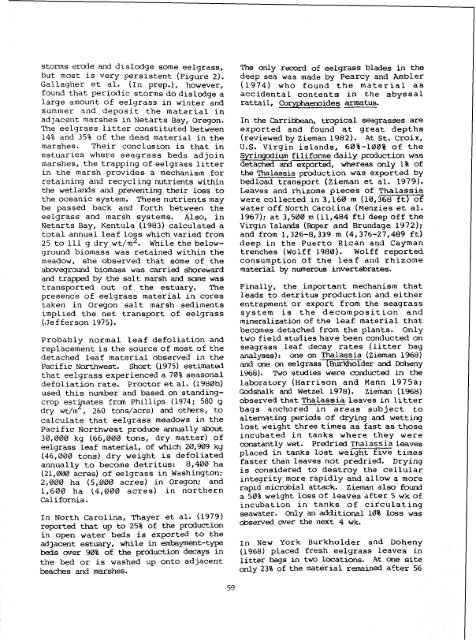The ecology of eelgrass meadows in the Pacific Northwest: A ...
The ecology of eelgrass meadows in the Pacific Northwest: A ...
The ecology of eelgrass meadows in the Pacific Northwest: A ...
- No tags were found...
Create successful ePaper yourself
Turn your PDF publications into a flip-book with our unique Google optimized e-Paper software.
storms erode and dislodge some <strong>eelgrass</strong>,<br />
but most is very persistent (~igure 2).<br />
Gallagher et al. (In prep.), however,<br />
found that ~eriodic storms do dislodge a<br />
large amount <strong>of</strong> eelyrass <strong>in</strong> w<strong>in</strong>ter and<br />
summer and deposit <strong>the</strong> material <strong>in</strong><br />
adjacent marshes <strong>in</strong> Netarts Bay, Oregon.<br />
<strong>The</strong> <strong>eelgrass</strong> litter constituted between<br />
14% and 35% <strong>of</strong> <strong>the</strong> dead material <strong>in</strong> <strong>the</strong><br />
marshes. <strong>The</strong>ir conclusion is that <strong>in</strong><br />
estuaries where seagrass beds ad jo<strong>in</strong><br />
marshes, <strong>the</strong> trapp<strong>in</strong>g <strong>of</strong> <strong>eelgrass</strong> litter<br />
<strong>in</strong> <strong>the</strong> marsh provides a mechanism for<br />
reta<strong>in</strong><strong>in</strong>g and recycl<strong>in</strong>g nutrients with<strong>in</strong><br />
<strong>the</strong> wetlands and prevent<strong>in</strong>g <strong>the</strong>ir loss to<br />
<strong>the</strong> oceanic system. <strong>The</strong>se nutrients )nay<br />
be passed back and forth between <strong>the</strong><br />
<strong>eelgrass</strong> and marsh systems. Also, <strong>in</strong><br />
Netarts Bay, Kentula (1983) calculated a<br />
total annual leaf loss which varied from<br />
25 to 111 g dry wt/m2. While <strong>the</strong> belowground<br />
biomass was reta<strong>in</strong>ed with<strong>in</strong> <strong>the</strong><br />
meadow, she observed that some <strong>of</strong> <strong>the</strong><br />
;Iboveground biomass was carried shoreward<br />
and trapped by <strong>the</strong> salt marsh and some was<br />
transported out <strong>of</strong> <strong>the</strong> estuary. <strong>The</strong><br />
presence <strong>of</strong> <strong>eelgrass</strong> material <strong>in</strong> cores<br />
taken <strong>in</strong> Oregon salt marsh sediments<br />
implied <strong>the</strong> net transport <strong>of</strong> <strong>eelgrass</strong><br />
(Jefferson 1975).<br />
Probably normal Leaf defoliation and<br />
replacement is <strong>the</strong> source <strong>of</strong> most <strong>of</strong> <strong>the</strong><br />
detached leaf material observed <strong>in</strong> <strong>the</strong><br />
<strong>Pacific</strong> <strong>Northwest</strong>. Short (1975) estimated<br />
that <strong>eelgrass</strong> experienceda70% seasonal<br />
defoliation rate. Proctor et al. (1980b)<br />
used. this number and based on stand<strong>in</strong>gcrop<br />
estynates from Phillips (1974; 580 g<br />
dry wt/m , 260 tons/acre) and o<strong>the</strong>rs, to<br />
calculate that <strong>eelgrass</strong> <strong>meadows</strong> <strong>in</strong> <strong>the</strong><br />
<strong>Pacific</strong> <strong>Northwest</strong> produce annually about<br />
30,000 kg (66,0(110 tons, dry matter) <strong>of</strong><br />
<strong>eelgrass</strong> leaf material, <strong>of</strong> which 20,909 kg<br />
(46,000 tons) dry weight is defoliated<br />
annually to become detritus: 8,400 ha<br />
(21,000 acres) <strong>of</strong> <strong>eelgrass</strong> <strong>in</strong> Wash<strong>in</strong>gton;<br />
2,000 ha (5,BBB acres) <strong>in</strong> Oregon; and<br />
1,600 ha (4,000 acres) <strong>in</strong> nor<strong>the</strong>rn<br />
California.<br />
<strong>The</strong> only record <strong>of</strong> <strong>eelgrass</strong> blades <strong>in</strong> <strong>the</strong><br />
deep sea was made by Pearcy and Ambler<br />
(1974) who found <strong>the</strong> material as<br />
accidental contents <strong>in</strong> <strong>the</strong> abyssal<br />
rattail, Coqphaenoides armatus. -<br />
In <strong>the</strong> Carribbean, tropical seagrasses are<br />
exported and found at great depths<br />
(reviewed by Zieman 1982). At St. Croix,<br />
U.S. Virg<strong>in</strong> islands, 60%-1B0% <strong>of</strong> <strong>the</strong><br />
Syr<strong>in</strong>gcdium f ilifonne daily production was<br />
detached and exported, whereas only 1% <strong>of</strong><br />
<strong>the</strong> Thalassia production was exported by<br />
bedload transport (Zieman et al. 1979).<br />
Leaves and rhizome pieces <strong>of</strong> ~halassia<br />
were collected <strong>in</strong> 3,160 m (10,368 ft) <strong>of</strong><br />
water <strong>of</strong>f North Carol<strong>in</strong>a (Menzies et dl.<br />
1967); at 3,580 m (11,484 ft) deep <strong>of</strong>f <strong>the</strong><br />
Virg<strong>in</strong> Islands (Raper and Brundage 1972);<br />
and from 1,326-8,339 rn (4,376-27,489 ft)<br />
deep <strong>in</strong> <strong>the</strong> Puerto Rican and Cayman<br />
trenches (Wolff 1988). Wolff reported<br />
consumption <strong>of</strong> <strong>the</strong> leaf and rhizome<br />
material by numerous <strong>in</strong>vertebrates.<br />
F<strong>in</strong>ally, <strong>the</strong> important mechanis~n that<br />
leads to detritus production and ei<strong>the</strong>r<br />
entrapment or export from <strong>the</strong> seagrass<br />
system is <strong>the</strong> decomposition and<br />
<strong>in</strong><strong>in</strong>eralization <strong>of</strong> <strong>the</strong> Leaf material that<br />
becomes detached frorn <strong>the</strong> plants. Only<br />
two field studles have been conducted on<br />
seagrass leaf decay rates (litter bay<br />
analyses): one on Thalassia (~iemdn 1968)<br />
,md om on <strong>eelgrass</strong> (Burkholder and D<strong>of</strong>wny<br />
1968). Two studies were conducted <strong>in</strong> <strong>the</strong><br />
laboratory (~arrison and Mann 1975a;<br />
Wshalk and Wetzel 1978). Zieman (L%8)<br />
observedthat Thalasei* leaves <strong>in</strong> litter<br />
bags anchored <strong>in</strong> areas subject to<br />
alternat<strong>in</strong>g perids <strong>of</strong> dry<strong>in</strong>g and wett<strong>in</strong>g<br />
lost weight three times as fast as those<br />
<strong>in</strong>cubated <strong>in</strong> tanks where <strong>the</strong>y were<br />
constantly wet. Predried ~ hal ass ia leaves<br />
nlaced <strong>in</strong> tanks lost weiqht five tirnes<br />
;aster than leaves not predried. Dry<strong>in</strong>g<br />
is considered to destroy <strong>the</strong> cellular<br />
<strong>in</strong>tegrity more rapidly and allow a more<br />
rapid microbial attack. Zieman also found<br />
a 50% weight loss <strong>of</strong> leaves after 5 wk <strong>of</strong><br />
<strong>in</strong>cubation <strong>in</strong> tanks <strong>of</strong> circulat<strong>in</strong>q<br />
10% loss was<br />
~n ~ ~ Carol<strong>in</strong>a, ~ t mayer h et al. (1979) seawater. Only an additio~l<br />
reported that up to 25% <strong>of</strong> <strong>the</strong> production Observd <strong>the</strong> next wk*<br />
<strong>in</strong>- open water-beds is exported to <strong>the</strong><br />
adjacent estuary, while <strong>in</strong> embayment-type In New York Burkholder and Doheny<br />
beds over 90% <strong>of</strong> <strong>the</strong> production decays <strong>in</strong> (1968) placed fresh eelyrass leaves <strong>in</strong><br />
<strong>the</strong> bed or is washed up onto adjacent litter bags <strong>in</strong> two locations. At one site<br />
beaches and marshes. only 23% <strong>of</strong> <strong>the</strong> material rema<strong>in</strong>ed after 56

















